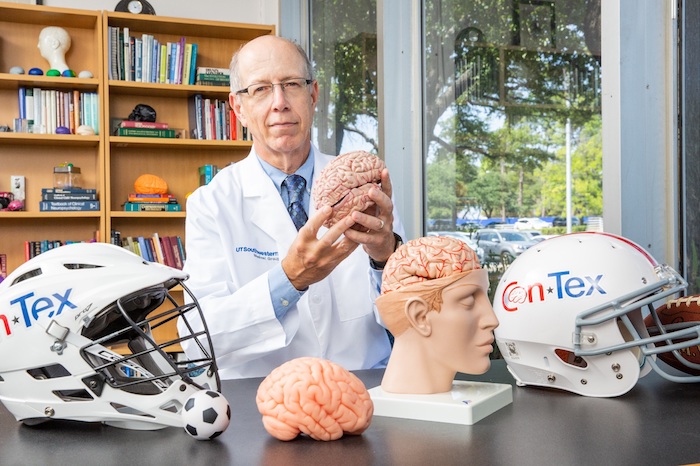Largest Texas high schools to report all concussions to statewide registry
Data to help scientists assess prevalence of brain injuries in youth sports
DALLAS – Aug. 21, 2019 – Starting this fall, the biggest public high schools in Texas are required to report all sports concussions to a central database as part of one of the nation’s largest statewide endeavors to track brain injuries in youth athletics.
The project, a partnership between UT Southwestern and the University Interscholastic League (UIL), is among multiple requirements recently implemented in Texas that signify a notable shift in how public schools are addressing rising concerns over player safety. Only a few states have applied similar requirements, and the addition of Texas brings heft to an emerging effort to fill a major gap in concussion research.
“The pendulum is swinging toward concussion awareness, yet there is still so much we don’t know about brain injury in middle and high school athletes,” said Dr. Munro Cullum, a neuropsychologist overseeing the database at UT Southwestern’s O’Donnell Brain Institute. “We need to get a sense of how many of these injuries are occurring. Then we can use the data to look for answers: Do concussion numbers decrease after a school gets new equipment? How do concussions vary by gender and age?”
Critical steps
While the NCAA, NHL, NFL, and other sports organizations are tracking the issue in the college and professional ranks, little has been done on a scale as large as Texas to evaluate concussions in youth athletics.
The project in Texas – which leads the U.S. with more than 800,000 students participating in high school sports – is part of the ConTex registry that launched in 2017 as a program for middle and high schools to voluntarily report concussions sustained during all UIL-sanctioned activities.
The UIL, which regulates athletics in Texas public schools, has now required that all Conference 6A schools participate in the registry, with the possibility of expanding the requirements to other schools in the future.
Schools in Conferences 1A-5A can continue participating on a voluntary basis, and scientists hope those reports can generate a large enough sample size to determine reliable concussion trends across the state.
“Ensuring the health and safety of our student participants is the most important thing we do,” said Charles Breithaupt, UIL Executive Director. “The UIL Medical Advisory Committee does excellent work recommending policies to make our activities as safe as possible, and this concussion registry will provide valuable information to help us continually improve the safety of extracurricular athletics.”
Among other recent changes, the UIL implemented a requirement that all middle and high school football coaches take a training course on best-practices for tackling. UIL previously implemented a practice limitation of 90 minutes of full-contact practice per athlete per week.
Collecting data
The ConTex registry, modeled after a smaller UT Southwestern study that tracks more detailed information about concussions in the Dallas-Fort Worth area, relies on athletic trainers and school personnel across Texas to report all concussions that occur in UIL athletics to a central database through an online site. Among the information being tracked is the cause of the injury, concussion history, the gender of the player, and other data. Students’ names and personal identifying information are not entered into the registry.

Dr. Cullum said his team will measure how often concussions occur in each sport and identify areas with differing rates. With more data, the team will eventually be able to examine whether certain practices are helping reduce concussions or shorten recovery times.
“Among other issues, we don’t know who’s at risk for prolonged recovery,” Dr. Cullum said. “Most people will be back to normal within a few weeks, but there are some who take longer. Why is that happening, and what can we do to change it? Collecting the data is setting the stage for a number of future projects.”
National efforts
All 50 states have passed legislation in recent years to address concussions in extracurricular athletics, but few have successfully launched statewide registries to track such injuries in all sports. Hawaii, for instance, launched its own registry in 2010, but the data have been relatively limited, with only several dozen high schools participating. Other states such as Michigan and Connecticut have launched their own registries.
However, evaluating youth sports concussions on a broader scale has been difficult with no national system in place to collect data from schools. Researchers instead have been forced to rely on surveys of hospital records that have only skimmed the surface of the issue.
For instance, findings released in 2016 by the Centers for Disease Control and Prevention show children under age 15 account for the most traumatic brain injury visits to the emergency room. But because most concussions do not end up in emergency rooms, the statistic does little to help researchers identify trends and factors that could have a meaningful impact on player safety.
Dr. Cullum said data collected from the schools are critical in that regard.
“This framework can be used in other states, maybe even for a national database,” he said. “But it’s vital that athletic trainers and other school personnel understand the importance of reporting their cases. Their contributions will ultimately lead to best-practices and help better protect student-athletes.”
About UT Southwestern Medical Center
UT Southwestern, one of the premier academic medical centers in the nation, integrates pioneering biomedical research with exceptional clinical care and education. The institution’s faculty has received six Nobel Prizes, and includes 22 members of the National Academy of Sciences, 17 members of the National Academy of Medicine, and 15 Howard Hughes Medical Institute Investigators. The full-time faculty of more than 2,500 is responsible for groundbreaking medical advances and is committed to translating science-driven research quickly to new clinical treatments. UT Southwestern physicians provide care in about 80 specialties to more than 105,000 hospitalized patients, nearly 370,000 emergency room cases, and oversee approximately 3 million outpatient visits a year.
